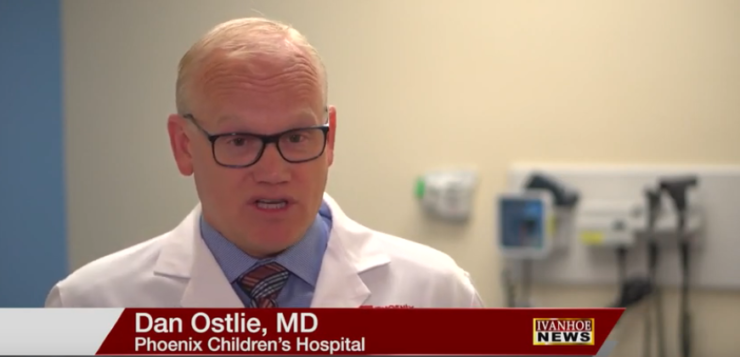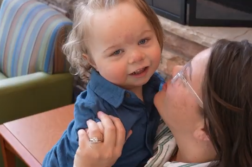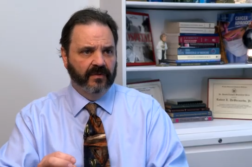Dan Ostlie, MD, Surgeon-in-Chief at Phoenix Children’s Hospital talks about a new way to help patients who undergo chest reconstruction with their pain relief.
Interview conducted by Ivanhoe Broadcast News in May 2019.
Tell us a little bit about what pectus is.
Pectus is a group of chest wall abnormalities. In general, we break them up into two dominant disorders. One is called pectus excavatum, or funnel chest, where the chest goes in. And the other is called pectus carinatum, or pigeon chest, where the chest wall comes out. It’s really a defect that’s related to chest wall growth. So as a child grows and they grow quickly in terms of vertical growth their chest has to grow as well. And that growth in the chest comes from the cartilage. And the cartilage is growing abnormally and really driving the sternum. The sternum is responding to what the cartilage is doing in relation to the cartilage trying to keep up to the child’s normal growth.
So it’s not something they were born with necessarily but developed during life?
OSTLIE: In general, we’d consider that they are not born with it. Although in pectus excavatum they can present very early, like in 1 to 2 years of age. If they present that early, that generally is an excavatum. But carinatum, the pigeon chest, usually shows up in kind of that 10 to 15 years of age.
What kind of problems does it cause for patients besides appearance?
OSTLIE: The pectus excavatum causes more problems and that’s because we lose chest volume. Because the chest is sinking in you lose the ability for the lungs to expand the appropriate way as well as for the heart to work as adequately as it’s supposed to. You can imagine as the sternum pushes down on the heart or the lungs, and it can’t push against that stiff chest wall. They don’t have the same respiratory capacity or cardiac output that they would have in a normal chest.
So what has the treatment been until a year and a half ago?
OSTLIE: The treatment for pectus excavatum has always been an operation if they’ve been symptomatic. A decade and a half ago, that operation was an open operation where they would actually make a sternotomy incision such as if we’d have a cardiac bypass operation. Then we’d go in and actually take out those cartilages and then break the sternum and allow it to come up and then put a little bar behind it. And about, oh, 12 to 14 years ago, the Nuss operation or the minimally invasive repair for pectus excavatum, became mainstream. That’s an operation where we make two or three small incisions around the chest, and we actually place a bar behind the chest through the subcutaneous tissue. That bar serves as a fulcrum to push the chest up where it belongs. What really happened at Phoenix Children’s Hospital about 18 months ago that changed the paradigm in terms of patient care is that we started to do cryoablation. Cryoablation is where we take a probe and we freeze the intercostal nerves. The intercostal nerves are the nerves that run underneath your ribs and give you sensation across the front of your chest. So we use a probe that freezes those nerves at minus 60 degrees centigrade for about two minutes. And we can do multiple levels of the nerves. We usually do four. And that causes the child to be numb across the front of their chest while the bar is in place initially and decreases the amount of pain they have associated with the repair.
Because otherwise it used to be painful?
OSTLIE: Very painful. I give the analogy of when you have braces. When you tighten up your braces, every time you tighten up the braces your teeth hurt. Well when we do a chest wall reconstruction, we fix the chest in 20 seconds. So if you can imagine having your teeth straightened in 20 seconds and the amount of discomfort you would have that’s similar to what we do when we fix the chest wall. Because we don’t do it gradually. We do it all at once.
It holds and nothing breaks?
OSTLIE: you can see breaks once in a while, but it’s very uncommon. I think in my experience it’s less than two or three percent of the time you’d have a fracture of a rib or the sternum related to the repair.
So we were told that people are seeking this out. Is it because of pain avoidance?
OSTLIE: So how do we treat pain? We treat pain with narcotics. Historically, what we have told people is that they should expect that their narcotic usage is going to be somewhere between three and six weeks after an operation. And now we see after doing the cryoablation that their narcotic usage is decreased at least by 50 percent in terms of the number and amount of narcotics. But also, the time has gone from that three to six weeks to really two weeks is the time they need the narcotics.
Tell us a little bit about Sebastian’s case.
OSTLIE: Sebastian was a child who presented with pretty classic symptoms of pectus excavatum. He was very short of breath -and it started to affect his lifestyle. He wasn’t able to keep up with his peers. He did have some discomfort in his chest which is also common with pectus excavatum. We did the standard workup which includes doing an MRI of the chest to look at what his chest looked like as well as the compression on his heart. It allows us to calculate how bad his excavatum was. He also gets a pulmonary function test and a stress exercise test to see how he’s doing physiologically and then an echocardiogram to look at his heart. And after all those things, we decided that he was a great candidate for the minimally invasive repair, which we counseled him about and told him what the expectations were and that he’d have a good outcome and have a flat chest. He was the very first patient we did cryoablation on, so we spent a long time talking about using cryoablation as an adjunct to pain control, what our expectations were in terms of how it would work as well as the amount of time that he would be numb, which we expected to be two to three months based on previous reports. He was a very willing patient. I think he saw that opportunity as an opportunity not to be on narcotics and to get back to his lifestyle more normally. Luckily the operation went exactly the way we expected to and he’s had great pain control and a really excellent outcome with regard to his excavatum.
How long ago did you do it?
OSTLIE: Eighteen months ago.
And then how old was he then?
OSTLIE: Sixteen
What haven’t I asked you about the procedure that you think that we should include in the story?
OSTLIE: The one thing I would say about chest wall reconstructions is you should go to a center of excellence. I think that the more chest wall reconstructions that are being done in the hospital the better that you’re going to be treated in terms of algorithmic care, standard of care, pain management, cryoablation technique. And I just think that volume is a definite thing that is
END OF INTERVIEW
This information is intended for additional research purposes only. It is not to be used as a prescription or advice from Ivanhoe Broadcast News, Inc. or any medical professional interviewed. Ivanhoe Broadcast News, Inc. assumes no responsibility for the depth or accuracy of physician statements. Procedures or medicines apply to different people and medical factors; always consult your physician on medical matters.
If you would like more information, please contact:
Elaina Steingard, Media Relations Specialist
602-933-0824
esteingard@phoenixchildrens.com
Sign up for a free weekly e-mail on Medical Breakthroughs called First to Know by clicking here





